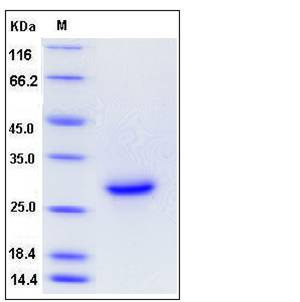Mouse Syndecan-4 / SDC4 Protein (His Tag)
AA959608,AW108331,ryudocan,Synd4,syndecan-4
- 100ug (NPP1596) Please inquiry
| Catalog Number | P50726-M08H |
|---|---|
| Organism Species | Mouse |
| Host | Human Cells |
| Synonyms | AA959608,AW108331,ryudocan,Synd4,syndecan-4 |
| Molecular Weight | The secreted recombinant mouse SDC4 comprises 134 amino acids and has a calculated molecular mass of 14.9 kDa. As a result of glycosylation, the recombinant protein migrates as an approximately 28 kDa band in SDS-PAGE under reducing conditions. |
| predicted N | Glu 24 |
| SDS-PAGE |  |
| Purity | > 95 % as determined by SDS-PAGE |
| Protein Construction | A DNA sequence encoding the mouse SDC4 (O35988) extracellular domain (Met 1-Val 146) was expressed, fused with a C-terminal polyhistidine tag. |
| Bio-activity | |
| Research Area | Developmental Biology |Embryogenesis |Axis Formation |Canonical Wnt Pathway |
| Formulation | Lyophilized from sterile PBS, pH 7.4 1. Normally 5 % - 8 % trehalose and mannitol are added as protectants before lyophilization. Specific concentrations are included in the hardcopy of COA. |
| Background | SDC4 (Syndecan-4), also known as Syn4, is a transmembrane heparan sulfate proteoglycan that co-operates with integrins during cell-matrix interactions for the assembly of focal adhesions and actin stress fibers and in the phosphorylation of focal adhesion kinase (FAK) on Tyr397. Syndecan-4 plays roles in the formation of focal adhesions and stress fibers. The cytoplasmic domain of syndecan-4 interacts with a number of signalling and structural proteins, and both extracellular and cytoplasmic domains are necessary for regulated activation of associated transmembrane receptors. Syndecan-4/SDC4 is a heparan sulfate proteoglycan and works as a coreceptor for various growth factors. SDC4 deficiency limits neointimal formation after vascular injury by regulating vascular smooth muscle cells (VSMCs) proliferation and vascular progenitor cells (VPCs) mobilization. Therefore, SDC4 may be a novel therapeutic target for preventing arterial restenosis after angioplasty. |
| Reference |
